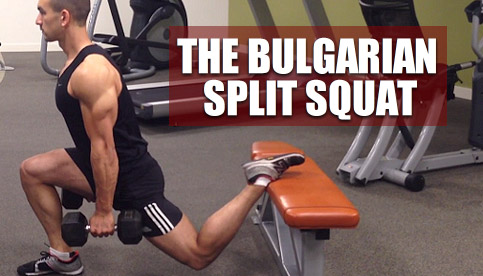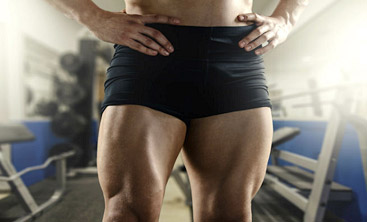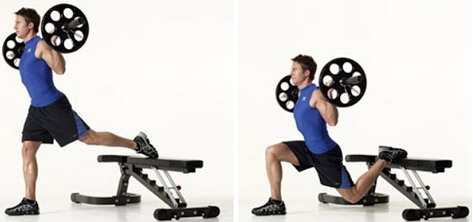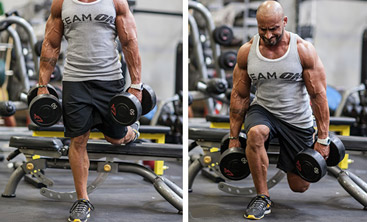BULGARIAN SPLIT SQUATS (BENEFITS AND PROPER FORM)

It might simply look like a “wimpy” alternative to a traditional barbell squat at first glance, but make no mistake: Bulgarian split squats are the real deal.
You won’t see these being performed very often at most gyms, but they’re a highly effective (and surprisingly challenging) way to train your lower body while minimizing lower back stress and without the need for any fancy equipment.
In this post I’ll be going over the main benefits of the Bulgarian split squat (also known as the “rear foot elevated split squat”) and outlining how to perform them correctly, as well as providing some additional form tips you can employ to ensure that you get the very most out of the exercise.
Let’s cover it…
Bulgarian Split Squat Benefits: 3 Reasons To Do Them

Why would you want to include a Bulgarian split squat in your workouts?
There are 3 main reasons to consider…
Reason #1: You have a lower back injury and need a safer alternative to traditional back squats.
The Bulgarian split squat places significantly less stress on the lower back area since you’ll be performing the movement one leg at a time and using a lot less total weight.
In addition, if you perform them using dumbbells like I recommend, you’ll be holding the weights at your sides as opposed to carrying a heavy loaded bar directly on your back.
As a result of these two differences, you’ll be able to directly load your quads, hamstrings and glutes with a large amount of resistance but with minimal compression on your spine.
Reason #2: You have equipment limitations that don’t allow for regular “heavy” leg training.
Perhaps you train from home and don’t have access to a squat rack or heavy dumbbells, or maybe you’re travelling and are limited to the basic equipment in your hotel gym.
With the Bulgarian split squat, all you need is a modest pair of dumbbells and a place to elevate your foot and you’ll be able to get a good leg workout in without the need for a squat rack or any machines.
If you go with a slower cadence and higher reps, this exercise can even be performed effectively without using any additional weights at all.
Reason #3: It’s simply an awesome lower body exercise, period.
The Bulgarian split squat is great for adding muscle size to your quads, hamstrings and glutes…
It builds significant single-leg strength and stability…
It’s a great functional movement with a variety of mobility, flexibility and proprioceptive benefits…
So even if you are using a traditional barbell squat as your primary lower body lift, you can still include the Bulgarian split squat as another exercise in your overall plan.
I understand that many lifters with the “hardcore” mentality may naturally steer clear of this exercise because it doesn’t allow you to handle very heavy weights and doesn’t appear as “tough” as a standard back squat does…
However, the goal of any exercise in the gym is to place the targeted muscles under tension through a proper range of motion and to progressively overload that lift over time, and the Bulgarian split squat absolutely allows you to do that very effectively.
Go ahead and test them out for yourself and you’ll quickly realize that this is far from a “wussy” exercise. When done properly, they’re actually a very demanding lift that require a good deal of focus and pain tolerance to perform.
In fact, new research has even shown that split squats may be just as effective as regular bi-lateral squats when it comes to increasing lower body strength and athletic performance…
Reference: Unilateral Vs. Bilateral Squat Training
“This is the first study to suggest that BI and UNI training interventions may be equally efficacious in improving measures of lower-body strength, 40-m speed, and change of direction in academy level rugby players.”
It is a difficult exercise to master from a technical standpoint though, so it’s very important that you understand the proper form first…
Proper Bulgarian Split Squat Form
1) Start off by standing in front of a flat bench with both feet together and holding a pair of dumbbells at your sides with your palms facing inward.
2) Place one foot back on the bench in a staggered stance with your toes pointing down and the top of your foot pressing flat against the bench.
3) Keep your chest up, core tight, and begin slowly lowering yourself under control by flexing the knee and the hip of your front leg. Continue descending until your knee is just short of touching the ground.
4) Once you reach the bottom position, push yourself back up by extending your front knee and hip at the same time and stopping just short of locking our your knee.
Note: You can also perform this exercise using a barbell if you prefer. My recommendation is to use dumbbells, but if you can position a bench behind a squat rack and safely un-rack the bar to get yourself into position, a Bulgarian barbell split squat is an option too…

In order to maximize the effectiveness of the exercise and minimize the risk of injury, here are some additional form tips to keep in mind…
Additional Bulgarian Split Squat Tips

Tip #1: If you’re brand new to this exercise then always start out with very light weights (or no weights at all) and practice the proper form first. The Bulgarian split squat may feel a bit awkward when you’re just getting started, and it does take some time to learn the proper technique and get your balance down. Once you’re comfortable with the movement you can begin gradually increasing the weight.
Tip #2: How far or close you stand away from the bench will depend on your individual body structure, so you’ll want to play around with it to find the position that’s most comfortable for you. The closer you stand, the more stress it will place on your quads, but the more stress it will place on your knee joint as well. The farther you stand, the more stress it will place on your groin and hip flexor and the more your lower back will arch. So again, make sure to experiment with different stances to find the one that feels most natural.
Tip #3: You can optionally place a folded pad on the ground underneath your front knee and use that as a reference point so you know how far down to lower yourself on each rep.
Tip #4: A standard flat bench works well in most cases, but if you find that your quad and hip flexor of the elevated leg feels overly stretched, you can alternatively use a smaller box or step so that your rear leg and foot is closer to the ground.
Tip #5: As you descend, don’t allow your front knee to travel past your toes. Doing so places a lot of stress on the knee joint.
Tip #6: Always focus on pressing yourself up through your heel rather than the ball of your foot. Again, this will minimize stress on your knees.
Tip #7: Do not allow the knee of your front foot to cave inward as you lower yourself. If it naturally tends to do that, consciously press it outward.
Tip #8: After your first set, you can place a marker on the ground where your front foot was (such as a 2.5 pound plate) so that you’ll know exactly where to position your front foot on each set for consistency.
Tip #9: If you’re progressing to heavier weights and find that your grip is getting overly fatigued, consider using a set of lifting straps or lifting hooks to assist you. This way you won’t have to worry about your forearms giving out and can place 100% focus on training your lower body.
The Bottom Line
If you’re looking for an effective alternative to traditional barbell squats or just want a new lower body exercise to include in your plan, give the Bulgarian split squat a try.
It may look easy at first glance, but you’ll quick discover just how demanding and downright effective it really is once you start performing it regularly.
If you found this article helpful, make sure to sign up for your FREE custom fitness plan below...




